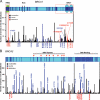Assessment of functional effects of unclassified genetic variants
- PMID: 18951449
- PMCID: PMC2771414
- DOI: 10.1002/humu.20899
Assessment of functional effects of unclassified genetic variants
Abstract
Inherited predisposition to disease is often linked to reduced activity of a disease associated gene product. Thus, quantitation of the influence of inherited variants on gene function can potentially be used to predict the disease relevance of these variants. While many disease genes have been extensively characterized at the functional level, few assays based on functional properties of the encoded proteins have been established for the purpose of predicting the contribution of rare inherited variants to disease. Much of the difficulty in establishing predictive functional assays stems from the technical complexity of the assays. However, perhaps the most challenging aspect of functional assay development for clinical testing purposes is the absolute requirement for validation of the sensitivity and specificity of the assays and the determination of positive predictive values (PPVs) and negative predictive values (NPVs) of the assays relative to a "gold standard" measure of disease predisposition. In this commentary, we provide examples of some of the functional assays under development for several cancer predisposition genes (BRCA1, BRCA2, CDKN2A, and mismatch repair [MMR] genes MLH1, MSH2, MSH6, and PMS2) and present a detailed review of the issues associated with functional assay development. We conclude that validation is paramount for all assays that will be used for clinical interpretation of inherited variants of any gene, but note that in certain circumstances information derived from incompletely validated assays may be valuable for classification of variants for clinical purposes when used to supplement data derived from other sources.
(c) 2008 Wiley-Liss, Inc.
Figures



References
-
- Antoniou AC, Pharoah PD, Narod S, Risch HA, Eyfjord JE, Hopper JL, Olsson H, Johannsson O, Borg A, Pasini B, others Breast and ovarian cancer risks to carriers of the BRCA1 5382insC and 185delAG and BRCA2 6174delT mutations: a combined analysis of 22 population based studies. J Med Genet. 2005;42(7):602–3. - PMC - PubMed
-
- Baer R, Ludwig T. The BRCA1/BARD1 heterodimer, a tumor suppressor complex with ubiquitin E3 ligase activity. Curr Opin Genet Dev. 2002;12(1):86–91. - PubMed
-
- Becker TM, Rizos H, de la Pena A, Leclercq IA, Woodruff S, Kefford RF, Mann GJ. Impaired inhibition of NF-kappaB activity by melanoma-associated p16INK4a mutations. Biochem Biophys Res Commun. 2005;332(3):873–9. - PubMed
-
- Becker TM, Rizos H, Kefford RF, Mann GJ. Functional impairment of melanoma-associated p16(INK4a) mutants in melanoma cells despite retention of cyclin-dependent kinase 4 binding. Clin Cancer Res. 2001;7(10):3282–8. - PubMed
Publication types
MeSH terms
Grants and funding
LinkOut - more resources
Full Text Sources
Other Literature Sources
Medical
Miscellaneous

